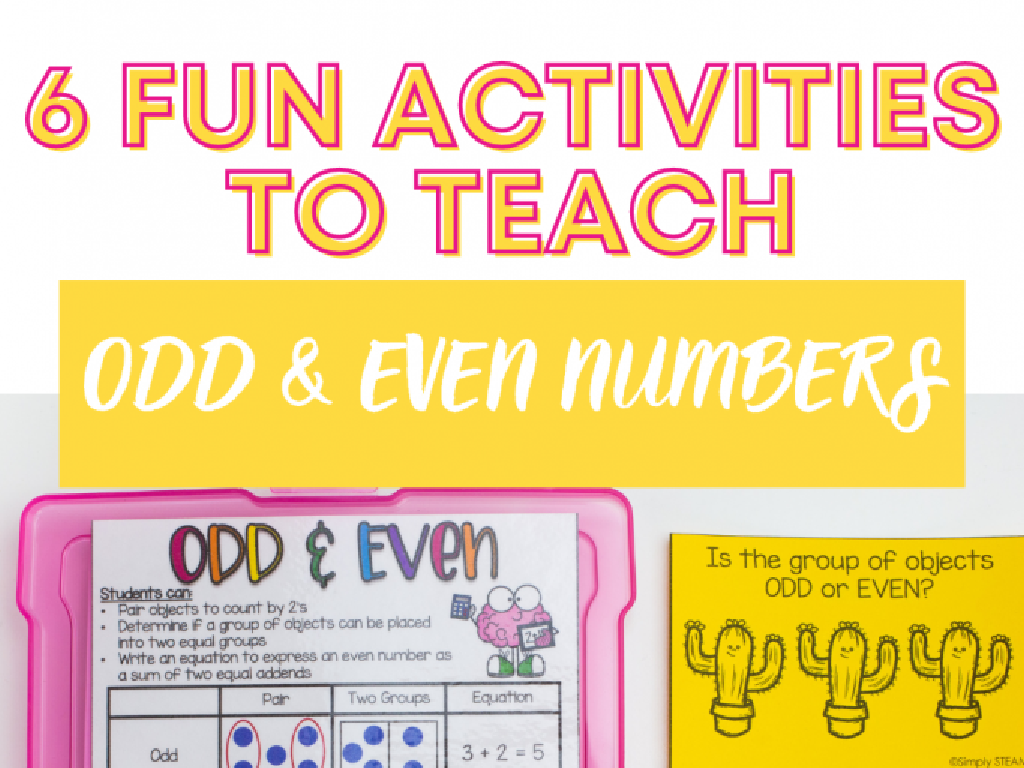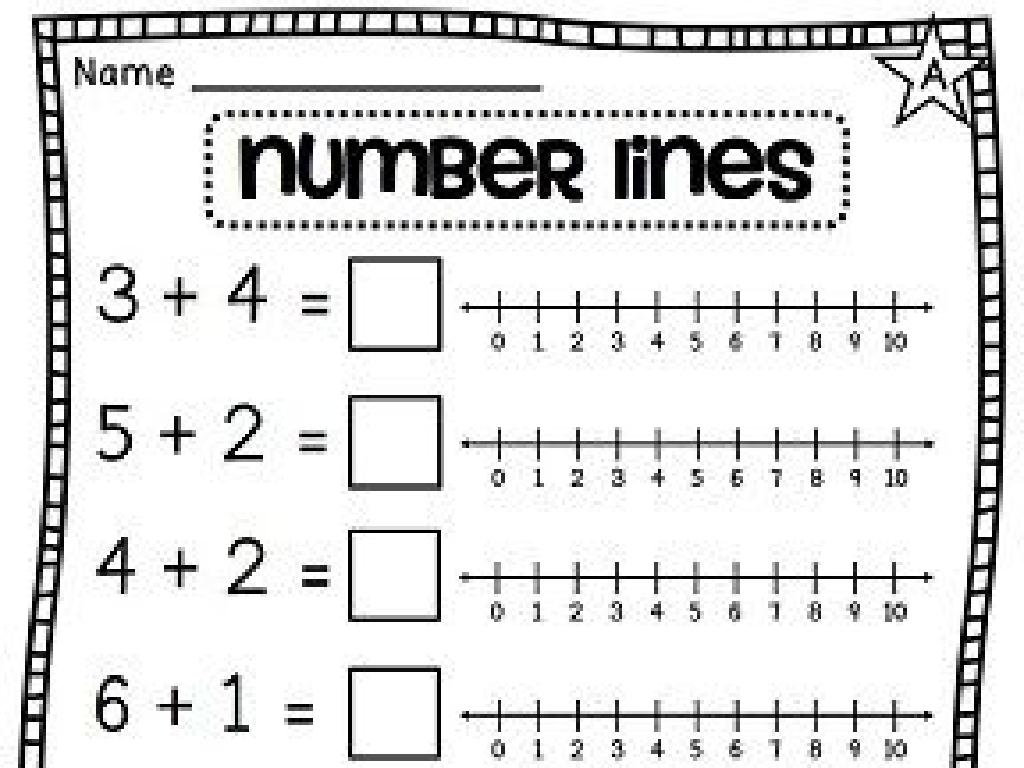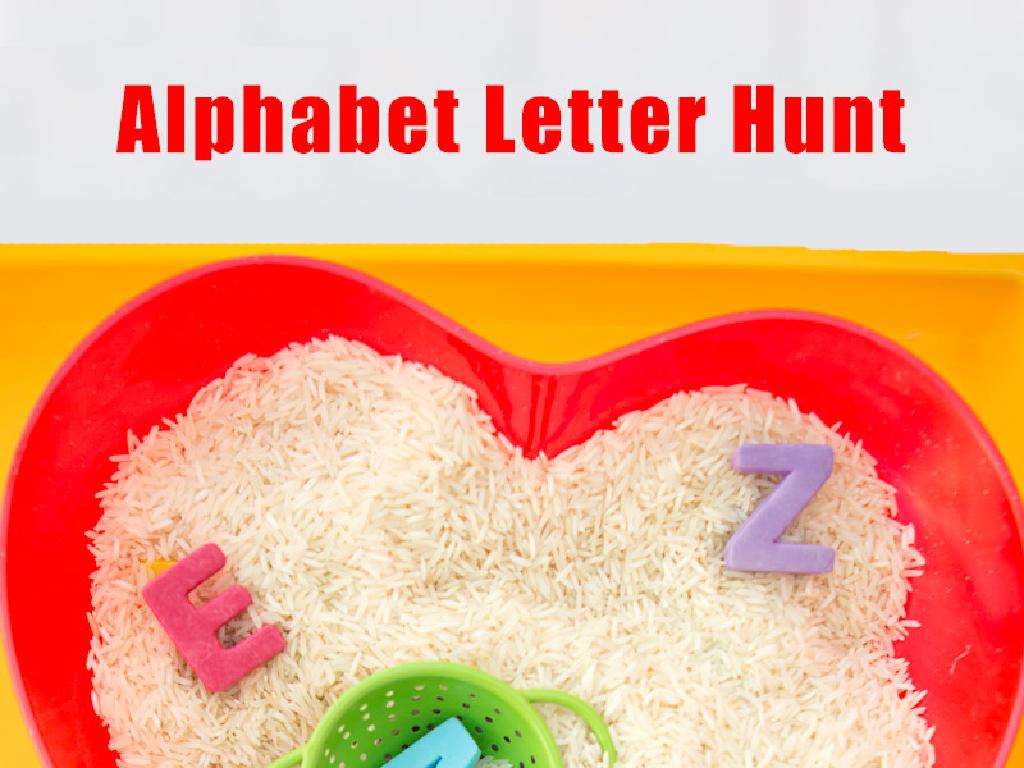Subtraction Facts - Up To 10
Subject: Math
Grade: First grade
Topic: Subtraction Up To 10
Summary: This first grade math presentation introduces subtraction facts up to 10 using engaging examples like toys, cookies, and apples. Students learn the concept of 'taking away' through hands-on activities, games with dice, and Subtraction Bingo for interactive practice. Visual aids and finger counting help solidify understanding, while games and real-life scenarios make learning subtraction both fun and effective. Regular practice is encouraged to build subtraction confidence and mastery.
Please LOG IN to download the presentation. Access is available to registered users only.
View More Content
Welcome to Subtraction!
– Learning to take away numbers
– Subtraction as ‘how many left’
– If you have 5 toys and give away 2, how many do you have left?
– Example with cookies
– Imagine you had 10 cookies and ate 3, how many cookies are left?
– Practice with numbers up to 10
– We’ll subtract numbers like 8 – 6, 7 – 5, and 9 – 4 together!
|
This slide introduces the concept of subtraction to first graders by relating it to a tangible scenario like cookies being eaten, which they can easily visualize and understand. Start by explaining that subtraction is simply the process of finding out how many things are left after some are taken away. Use real-life examples that are relevant to the students, such as toys or cookies, to illustrate the concept. Then, guide the students through several practice problems, using numbers up to 10 to solidify their understanding. Encourage the students to use their fingers or counters to help them visualize the subtraction process.
Understanding Subtraction
– Subtraction means taking away
– It’s like removing items from a group.
– Example with apples
– If you have 5 apples and give 2 away, you have 3 left.
– The ‘-‘ symbol
– We use this symbol to show subtraction.
|
This slide introduces the concept of subtraction to first graders. Subtraction is explained as the process of taking away one number from another. Use tangible examples, such as having a certain number of apples and giving some away, to illustrate the concept. Show the subtraction symbol ‘-‘ and explain that it is used to indicate that we are taking away. Encourage students to think of subtraction as a simple action of removing items and counting what is left. Use props or visuals like actual apples or apple cutouts to demonstrate the concept in a way that is engaging and easy to understand for young learners.
Mastering Subtraction Facts Up to 10
– What are subtraction facts?
– Simple math problems like 5 – 3 or 7 – 4
– Why learn subtraction facts?
– Helps with subtracting larger numbers in future
– Examples of subtraction facts
– Let’s solve 8 – 6 and 9 – 2 together!
– Practice makes perfect
|
This slide introduces first graders to the concept of subtraction facts, which are basic subtraction problems that can be solved quickly and without the use of fingers or counting aids. Emphasize the importance of memorizing these facts as they form the foundation for more complex arithmetic. Provide clear examples on the board and solve them as a class, ensuring that students understand the process. Encourage students to practice these facts regularly to improve their speed and confidence in subtraction. The goal is for students to be able to recall subtraction facts up to 10 instantly and accurately.
Subtraction Facts: Learning with Fingers
– Start with 5 fingers up
– Put 2 fingers down
– Count the fingers still up
– How many are left up?
– Discover the answer is 3
– 5 minus 2 equals 3
|
This slide is designed to teach first graders the concept of subtraction using a hands-on approach. By visualizing the subtraction of 5 minus 2, students use their fingers to physically represent the numbers, making the abstract concept of subtraction more concrete. Encourage the students to actively participate by following along with their own hands. After putting two fingers down, prompt them to count the remaining fingers to find the answer. Reinforce the concept by repeating with different numbers and ensure that students understand that subtraction means taking away. This tactile method helps solidify the subtraction concept in young learners’ minds.
Subtraction Facts: 8 – 3 Example
– Start with 8 candies
– Give away 3 candies
– Count remaining candies
– How many are left after sharing?
– Discover you have 5 candies
– 8 candies minus 3 equals 5 candies
|
This slide is designed to help first graders visualize subtraction as a process of giving away or taking away from a total amount. By imagining they have 8 candies and then give 3 away to a friend, they can physically count the remaining candies to find the answer. This concrete example helps solidify the concept of subtraction. Encourage the students to use their fingers or objects to represent the candies and to count out loud as they subtract. This interactive approach will help them understand that subtraction is simply finding out how many are left after some are taken away. The goal is to make them comfortable with basic subtraction facts up to 10.
Let’s Practice Subtraction Together!
– I’ll show a subtraction problem
– Use fingers or desk objects to solve
– Count backwards to subtract numbers
– Ready? Let’s solve problems together!
– Example: 10 – 2, put up 10 fingers, put 2 down
|
This slide is designed to engage students in a hands-on subtraction activity. Display a subtraction problem and guide them to use their fingers or objects like pencils or erasers to find the answer. This tactile approach helps reinforce the concept of ‘taking away’ in subtraction. Encourage students to count backwards from the larger number. For example, if the problem is 10 – 2, they should put up 10 fingers and then put 2 down to see what they have left. Offer several problems of varying difficulty and ensure to praise their efforts to build confidence. This activity can be done individually or in small groups to foster collaboration.
Subtraction Game with Dice
– Roll dice twice for numbers
– Find the bigger number
– Which number is more?
– Subtract the smaller from bigger
– Take away the little number from the big one
– Write down the answer
– Use your fingers or draw dots to help count
|
This interactive game is designed to help first graders practice subtraction facts up to 10 in a fun and engaging way. Provide each student with a pair of dice and a worksheet to record their rolls and answers. Encourage them to roll the dice twice to get two different numbers. Guide them to identify the larger number and then subtract the smaller number from it. This activity will help them understand the concept of subtraction as ‘taking away’. For students who may struggle, suggest using physical objects like counters or drawing dots to visualize the subtraction. Have them write down their final answer to reinforce the learning. Rotate around the room to assist and ensure understanding. Possible variations of the activity could include using number cards instead of dice, pairing students to take turns, or challenging them to find as many subtraction facts as they can within a set time limit.
Class Activity: Subtraction Bingo
– Receive your Bingo card
– Listen for called out numbers
– Mark answers on your card
Find the subtraction problem that equals the called number.
– Aim for five in a row to win
|
This interactive game is designed to help first graders practice subtraction facts up to 10 in a fun and engaging way. Each student will receive a Bingo card filled with subtraction problems instead of numbers. As the teacher calls out numbers, students must solve the subtraction problems on their cards to find the answer that matches the called number. When they find a match, they mark it on their card. The goal is to get five correct answers in a row, either horizontally, vertically, or diagonally. The first student to achieve this calls out ‘Bingo!’ and wins the game. This activity not only reinforces subtraction skills but also encourages listening and quick thinking. Possible variations of the game could include playing for different patterns on the Bingo card or having students create their own cards with subtraction problems.
Subtraction Success!
– Congratulations on learning subtraction!
– Practice is key to success
– The more you practice, the better you’ll get!
– Keep practicing to become a star
– Try subtracting with toys, fingers, or drawings
– You’re doing great!
|
This slide is meant to celebrate the students’ accomplishment in learning subtraction facts up to 10. It’s important to encourage them to continue practicing to reinforce their skills. Suggest fun ways to practice, like using toys or drawing pictures to visualize the problems. Remind them that everyone learns at their own pace, and with consistent practice, they’ll become proficient in subtraction. As a teacher, you can provide additional worksheets, use interactive games, or even have students practice with each other to keep them engaged and improving.





